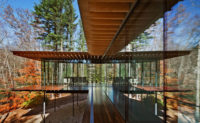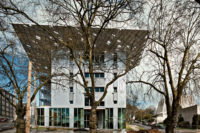Crimped and folded like the tectonic plates of the nearby Papago and Camelback Mountains, the roof that tops the Tempe Center for the Arts provides the facility with its signature element. Made of concrete over metal deck and supported by exposed tubular trusses, the iconic roof shelters the collection of programmatic elements that compose the $67.6 million center, including a 600-seat proscenium theater, a 200-seat studio theater, and a 3,500-square-foot gallery. The architects, Barton Myers Associates of Los Angeles, and local firm Architekton, conceived these as discrete volumes, each with its own roof below the enveloping structure.
This “box within a box” system serves an acoustical function, with the outer roof providing the first line of defense against the noise of jets on their way to and from Phoenix’s Sky Harbor Airport, only 2 miles away from the building’s site at the edge of Tempe’s Town Lake, says Peter Rutti, Barton Myers senior associate. The outer roof’s peak, about 100 feet above grade, is supported by a series of steel columns that sits on the concrete perimeter walls of the main theater fly tower. At the base of the columns are laminated rubber-and-steel-plate bearing pads. These isolators allow transfer of gravity loads but mitigate transfer of lateral loads induced by airborne vibration into the performance spaces, explains structural engineer Bruce Danziger, associate principal in the Los Angeles office of Arup.
Of the many volumes sheltered under the great roof, the main theater, with its poured-in-place ribbed dome spanning 76 feet, is the most complex. And much of its complexity is for acoustical reasons. According to Kurt Graffy, principal consultant with Arup Acoustics, in San Francisco, the lamella pattern of radiating beams aids the distribution of sound that would otherwise unevenly collect within the dome’s curved surface. The room’s size and physical characteristics provide “dry” conditions, or short reverberation times, best suited for dramatic presentations. However, an electro-acoustic enhancement system simulates the room volume and finishes that provide the longer reverberation times necessary for classical music, says Graffy.
Paradoxically, in order to ensure that the intricate dome was built correctly, the structural drawings called out the radii and elevations, but did not specify the dimensions of all of the components. “It is important to give only the necessary geometric information that can be used to establish the dimensions of each element,” says Danziger. The practice “forces the contractor to really understand the geometry and helps limit the possibility of errors in the drawings due to changes,” he adds.
So, before beginning construction, the contractor’s project manager built several scale models. And the fabricator of the fiberglass formwork worked in 3D CAD to generate shop drawings. “If we were to build the dome today, we would use BIM (building information modeling),” says Bill Okland, president of Tempe-based Okland Construction.
To build the actual dome, the contractor first installed a temporary “dance floor” at the theater’s eventual catwalk level to protect crews working on the room’s interior while roof construction moved forward. They then erected a skeletal dome-shaped structure of glue-laminated beams to support the formwork.
Within the forms, workers installed a dense network of rebar before placing the dome’s self-consolidating concrete in a single 8-hour pour to create the 6-inch-thick shell, and the 6-inch-deep and 10-inch-deep ribs. Then they waited a nerve-racking seven days before stripping the forms and removing the wood beams. Though the work went smoothly, Okland says the dome “was the most technically challenging concrete we’ve ever poured.”





















